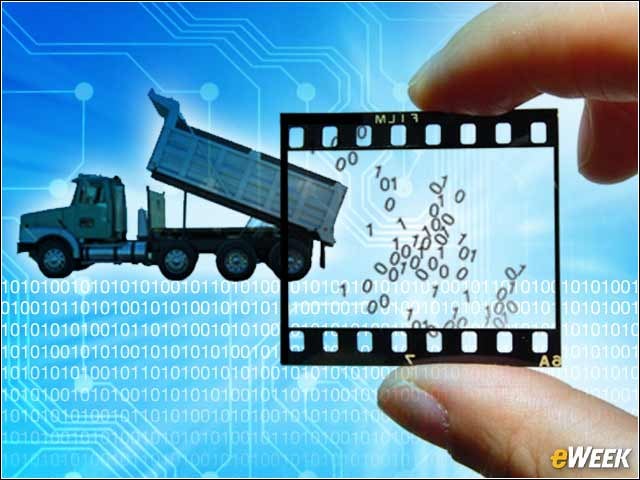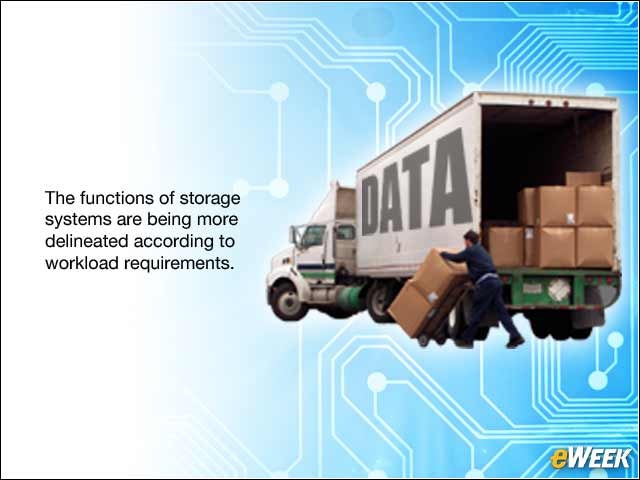eWEEK content and product recommendations are editorially independent. We may make money when you click on links to our partners. Learn More.
2Data, Data and More Data
With the advent of big data, real-time analytics and intelligence, as well as the Internet of things, storage networks are straining to keep up with data growth. More is more in this instance, as more content is driving the need for both greater capacity and performance. In addition, virtualization has forever altered storage workloads and the architecture that supports them. Operating systems, storage stacks, file systems, SAN and NAS have all been dramatically changed by virtualization, and the performance characteristics have shifted radically, exposing the limitations of existing storage designs.
3More Capacity Not Always the Best Solution
Traditionally, organizations most often simply buy more storage (resulting in capacity they don’t need), or they upgrade arrays to meet performance requirements. However, there are better options available for enhancing storage performance and capacity, without subjecting IT teams to forklift upgrades or exorbitant costs.
4Architecture Separating into Performance, Capacity Layers
We’re seeing the purchase and deployment of storage performance become separated from storage capacity in order to meet the conflicting demands of speed and capacity. The Internet of things and massive multimedia consumption are key drivers. This decoupling will fit smoothly into the future of performance needs, and it won’t require more cost.
5VMware’s Virtual Volumes Offer Fundamental Storage Shift
VMware’s Virtual Volumes (VVOLs) will fundamentally change the options for managing individual virtual machines (VMs) on storage. VVOLs allow IT teams to better distribute applications and VMs across storage, as they improve administrator control over the storage for any particular VM. Disk arrays can identify which piece of storage is mapped to a specific VM, enabling granular tiering, data protection and other operations.
6Data Protection Moves to the Cloud
No one can ignore the economics of cloud storage. As more companies choose snapshots over traditional backup, cloud and data protection become a perfect combination. There’s a lot of benefit to this in that snapshots are less expensive to operate, and they provide easier recovery. Snapshots stored on cloud-based object storage will continue replacing traditional corporate backups in the future.
7Spinning Shingled/SMR Drives a Good Choice for High Capacity
All-flash arrays are winning popularity contests, but spinning media is not disappearing. Shingled magnetic recording (SMR) drives, just coming on the market, will deliver much greater capacity value than flash. SMR drives capitalize on higher-tolerance disk heads that more narrowly read tracks, shrinking the space between them and partially shingling them, like what you see on your roof. But because adjacent tracks are not independent and are partially overlapping, writing a track can cause a cascading rewrite of the adjacent tracks, as well, which can slow performance. To minimize this effect, tracks are grouped into bands with a slightly larger gap between bands. This all makes SMRs a good fit for high volumes of data that are not often changed—the majority of data in most environments.
8Invest in Performance to Solve Performance Issues
It’s no secret that cost-effective solutions and high-speed, low-latency access are at odds, and there’s no end in sight as both big data and unstructured data continue to grow exponentially. There is a need to consider an alternative storage architecture strategy whereby companies are separating the performance and capacity layers from each other. Given their opposing requirements and cost structures, they are evolving away from each other. Companies shouldn’t have to buy more storage to solve performance issues because there are more efficient targeted solutions that can solve real performance problems.
9NVDIMM: Next Generation on the Horizon
Non-volatile memory interfaces will present significant performance advances as the server-attached flash market continues growing. We can expect to see non-volatile dual in-line memory modules (NVDIMM) backed by flash initially, costing mainstream users a heavy price. (NVDIMM is a DRAM DIMM that retains data even when electrical power is removed.) Then, non-volatile memory can be expected to interface directly to a memory DIMM slot. This will complete writes in under 10 microseconds, which is significantly faster than current flash solutions.
10‘Hyperconvergence’ Buzz Is Belied by Deployment Realities
“Hyperconvergence” is a major buzz phrase right now, and vendors are launching offerings left and right. But some of the industry giants are missing the boat here because, while they feel that it is a competitive offering, the market data says this new IT isn’t selling right now. Architectural limitations and interdepartmental infighting limits most deployments to primarily small environments or remote offices.
11Next-Gen Virtual SANS (vSAN) Are Coming of Age
VMware’s vSAN has evolved past 1.0 and now supports native snapshots, all-flash configurations and more. It is now a candidate to be considered as a viable technology outside of testing and development as its capabilities and functionality mature. It’s also a strong indicator of the market’s appreciation of the value of leveraging commodity hardware in the right places.










